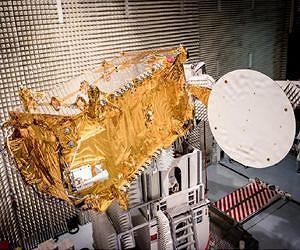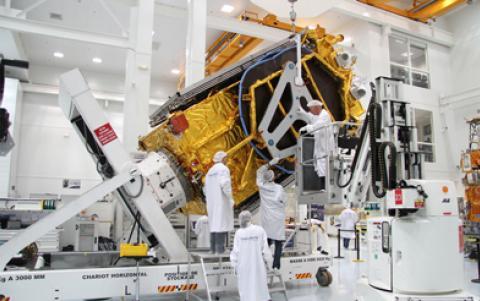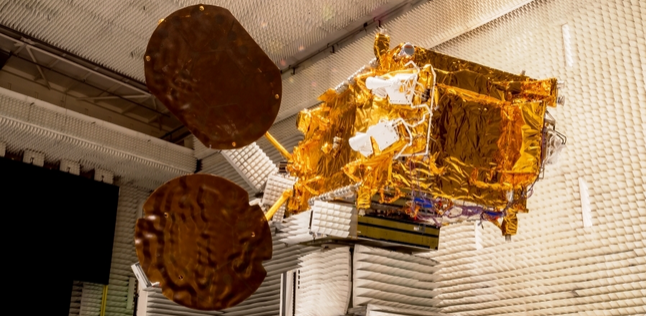The true generosity of Turkmenistan toward their people in terms of launching a new satellite system for ‘helping’ with entertainment and news is rather dubious, coming from a draconian isolationist government that rules with repression. Their government was, however, generous enough to let us launch their new satellite today, making history in a couple of ways.
Launched early this morning from Florida’s famed Cape Canaveral in coordination with several other entities, the TurkmenAlem52E/MonacoSAT telecommunications satellite does boast something new technologically, indeed signalling the wave of a new beginning in how components are made for various spacecraft.
The satellite will make the history books as the first satellite sent into orbit bearing a 3D printed component.
 Serving as a perfect example of how 3D printing right now is working with traditional manufacturing in making products where there is no negotiating regarding quality and performance, the TurkmenAlem52E/MonacoSAT, made by Thales Alenia Space, was constructed using 3D printing to make the T&C antenna horn mounting strut.
Serving as a perfect example of how 3D printing right now is working with traditional manufacturing in making products where there is no negotiating regarding quality and performance, the TurkmenAlem52E/MonacoSAT, made by Thales Alenia Space, was constructed using 3D printing to make the T&C antenna horn mounting strut.
The satellite is also making history with ‘flexible’ traveling wave tube amplifiers (TWTA), which provide adjustable output power.
Meant to have a longevity of 16 years, the satellite weighed 4.7 metric tons upon launching from Cape Canaveral. With the Turkmenistan Ministry of Communications using Monaco’s 52E orbital position through the Space System International – Monaco, this satellite will have the ability to cover:
- Europe
- Central Asia, to China border
- Nearly all of Africa
“This satellite will boost the quality of broadcasts of national television and radio channels and will create conditions for live TV (and) a high-quality system for the Internet,” said Turkmenistan’s President Gurbanguly Berdymukhamedov. “…It will be followed by further successes of the country, now already on a cosmic level.”
 While communications, internet, and access to the rest of the world is questionable in Berdymukhamedov’s country, chosen contractor Thales Alenia Space is certainly moving further on the map as a leader in aerospace manufacturing, and as the primary contractor chosen for this delivery. They were responsible for:
While communications, internet, and access to the rest of the world is questionable in Berdymukhamedov’s country, chosen contractor Thales Alenia Space is certainly moving further on the map as a leader in aerospace manufacturing, and as the primary contractor chosen for this delivery. They were responsible for:
- Designing and manufacturing the satellite
- Producing equipment for two ground satellite control stations
- Handling all associated services, including provision of launch services
With the use of 3D printing in aerospace components actually being sent into orbit, this is of course most likely just the beginning for use of the innovative and affordable technology. Thales Alenia Space, a French-Italian company, is headquartered in six countries, including the US, and employs 7,500 people. They’ve historically been responsible for building and manufacturing modules for vehicles like space shuttle orbiters, as well as several modules for the International Space Station.
The government’s satellite was launched by California-based SpaceX, a progressive company we’ve reported on many times, mainly regarding supply ships they have been rocketing into space for docking at the ISS, bearing thousands of pounds of goodies to include the first 3D printer in space and materials. The supply ship, the Dragon, has also returned, bearing 3D models that were actually 3D printed from space—amazing times that these are—with everything to be analyzed and inspected for future project planning.
How do you see 3D printing impacting space travel as a whole? Share your thoughts with us in the Turkmenistan Satellite Bearing 3D Printed Strut forum thread over at 3DPB.com.
Subscribe to Our Email Newsletter
Stay up-to-date on all the latest news from the 3D printing industry and receive information and offers from third party vendors.
You May Also Like
Why Corrosive Resistant Materials Are Important to the Success of 3D Printing Across Industries
The adoption of additive manufacturing (AM) is accelerating across many major industries. As this technological shift unfolds, the importance of corrosion resistance has emerged as a challenge for 3D printing...
America Makes Announces IMPACT 2.0: $6.6M in New 3D Printing Funding
America Makes, the Manufacturing Innovation Institute (MII) based in Youngstown, Ohio, has announced IMPACT (Improvement in Manufacturing Productivity via Additive Capabilities and Techno-Economic Analysis) 2.0, a project call which will...
3D Printing Webinar and Event Roundup: April 14, 2024
We’re starting off the week’s 3D printing webinars and events at ASTM AMCOE’s 11th Snapshot Workshop and MACH Exhibition. Stratasys continues its advanced training courses, SME is holding a virtual...
AMUK Welcomes Airframe Designs as British 3D Printing Industry Grows
While the UK is not the hub for 3D printer and materials manufacturers as other nations, the country continues to excel at the research, development, and application of additive manufacturing...
































